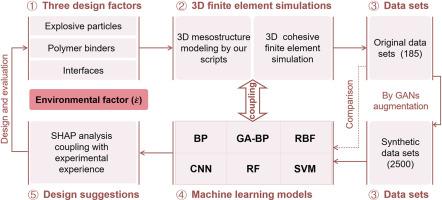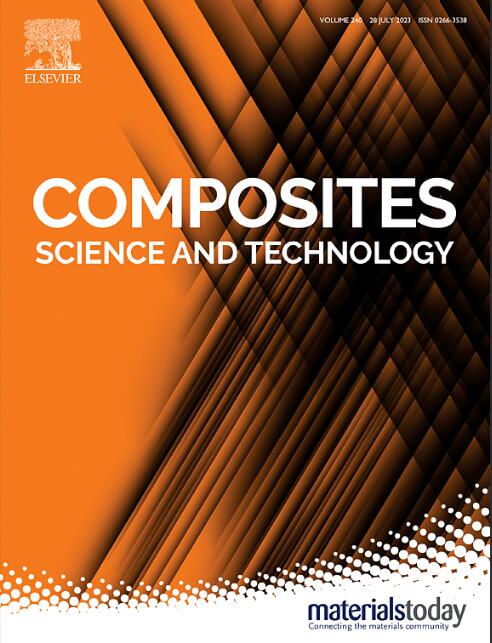Three-dimensional cohesive finite element simulations coupled with machine learning to predict mechanical properties of polymer-bonded explosives
IF 8.3
1区 材料科学
Q1 MATERIALS SCIENCE, COMPOSITES
引用次数: 0
Abstract
Developing multifactorial predictive models for the design of polymer-bonded explosives (PBXs) is of importance for their further application in insensitive munition fields. As a popular method, finite element simulations can provide a reliable prediction, but are laborious and expensive if considering the extensive design parameter space. In light of this challenge, we proposed a coupled strategy that includes machine learning (ML) and three-dimensional cohesive finite element simulation for effciently predicting the mechanical properties of PBXs. The strain rate, particle volume fraction, interface strength, fracture energy, and the binders are considered as the main factors of tailoring the tensile strength of PBXs. To improve the prediction performance, an augmented database of 2500 data sets utilizing GANs neural network were established and then processed to train and test six ML models. The results show the accuracy and generalizability of the low-computational-cost ML models in predicting the mechanical properties of PBX composites. The predicted values from these models are in good agreement with the experimental ones. Feature contribution analysis demonstrates that the tensile modulus and failure strain are most affected by the binders, while the tensile strength are most affected by the fracture energy. Using the above conclusions as design guidelines, we can develop the new PBX formulations according to different mechanical property requirements for their optimal use across insensitive ammunitions. This strategy can be a viable machine-learning-assisted solution to designing PBXs.

三维内聚有限元模拟与机器学习相结合,预测聚合物粘合炸药的机械特性
为聚合物粘结炸药(PBX)的设计开发多因素预测模型对其在非敏感弹药领域的进一步应用具有重要意义。作为一种常用方法,有限元模拟可以提供可靠的预测,但如果考虑到广泛的设计参数空间,这种方法既费力又昂贵。有鉴于此,我们提出了一种包含机器学习(ML)和三维内聚有限元模拟的耦合策略,用于有效预测 PBX 的机械性能。应变率、颗粒体积分数、界面强度、断裂能和粘合剂被视为定制 PBX 拉伸强度的主要因素。为了提高预测性能,利用 GANs 神经网络建立了一个包含 2500 个数据集的增强数据库,然后对其进行处理,以训练和测试六个 ML 模型。结果表明,低计算成本的 ML 模型在预测 PBX 复合材料机械性能方面具有准确性和通用性。这些模型的预测值与实验值十分吻合。特征贡献分析表明,拉伸模量和破坏应变受粘合剂的影响最大,而拉伸强度受断裂能的影响最大。以上述结论为设计准则,我们可以根据不同的机械性能要求开发新的 PBX 配方,使其在不敏感弹药中得到最佳应用。这种策略可以成为设计 PBX 的一种可行的机器学习辅助解决方案。
本文章由计算机程序翻译,如有差异,请以英文原文为准。
求助全文
约1分钟内获得全文
求助全文
来源期刊

Composites Science and Technology
工程技术-材料科学:复合
CiteScore
16.20
自引率
9.90%
发文量
611
审稿时长
33 days
期刊介绍:
Composites Science and Technology publishes refereed original articles on the fundamental and applied science of engineering composites. The focus of this journal is on polymeric matrix composites with reinforcements/fillers ranging from nano- to macro-scale. CSTE encourages manuscripts reporting unique, innovative contributions to the physics, chemistry, materials science and applied mechanics aspects of advanced composites.
Besides traditional fiber reinforced composites, novel composites with significant potential for engineering applications are encouraged.
 求助内容:
求助内容: 应助结果提醒方式:
应助结果提醒方式:


